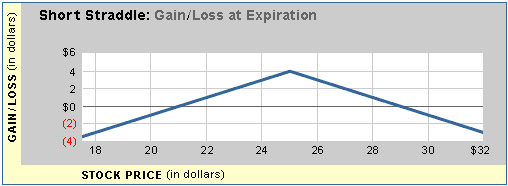Straddles
A strategy consisting of the purchase or sale of both a call and put option with the same expiration date and strike price. A long straddle offers an opportunity to make money when a stock or index moves substantially. A short straddle offers an opportunity to make money when a stock or index stays within a narrow range.
Long Straddles
Long straddles may allow an investor to profit from dramatic price movements in a specific security or index. An investor might employ a long straddle when he expects a surprising movement by the security, but is unsure of the direction. Long straddles involve simultaneously buying calls and puts with identical strike prices and expiration dates, typically ‘at-the-money’.
The investor may benefit from either a large increase or a large decrease in the price of the stock. However, the stock must move up or down further than the total premium paid for the investor to profit at expiration.
Prior to expiration, if the underlying security moves substantially up or down, the investor may choose to realize a profit by selling the in-the-money option before its expiration date. In this case, while the in-the-money option will have been losing time value since it was purchased, the losses in time premium are offset by the gains in intrinsic value. The investor may continue to hold the out-of -the-money option for the possibility to participate in any further, opposite movement by the underlying security. However, there is no guarantee the out of the money option would retain a high premium even with an increase in volatility.
Rather than selling following a dramatic price move, the investor can continue to hold both options until expiration - anticipating even more dramatic price movements in the future. However, unless such movements do occur, time decay will eventually take its toll on both options' premiums.
For use when investor anticipates:
- Dramatic movements in security price (e.g. due to an earnings announcement), but unclear whether movement will be up or down
- Increased volatility
Financial Characteristics:
- Maximum Loss: Total premiums paid
- Maximum Gain: Unlimited
- Loses value with time
Objective:
XYZ trades at $25.00/share. An investor anticipates that the stock will dramatically rise or fall in the near future. The investor purchases one at-the-money put for $2.00 and one at-the-money call for $2.00 to participate in large movements in either direction. Since each contract represents 100 shares, the total cost to the investor for buying both contracts is $400.00. To break even, the stock must either fall $4.00/share to $21.00 or rise $4.00/share to $29.00 at or before expiration. The investor will profit if the stock goes up more than $4.00/share or falls more than $4.00/share.

Short Straddle
Investors using the short straddle strategy anticipate that the underlying market/security of the options will trade in a narrow range and that large movements in either direction are unlikely. A short straddle will typically therefore involve the sale of at-the-money puts and calls with the same expiration date and strike price. The investor receives the premiums for the calls and puts and hopes that, at expiration, neither the call nor the put will be more in-the-money than the total premium received. The strategy exposes the investor to unlimited losses with the possibility of only limited profits. The investor might also sell a straddle at a strike that he/she expects the underlying security to move to by expiration.
For use when investor anticipates:
- Flat/Neutral market for the security
- Decreased volatility
Financial Characteristics:
- Maximum Loss: Unlimited
- Maximum Gain: Premiums received in the transaction
- Benefits from time decay
Objective:
- Speculative income generation
XYZ trades at $25.00/share. An investor believes that the stock will remain flat in the near term. He puts on a short straddle, selling one 25 call for $2.00 and selling one 25 put for $2.00. Since each contract represents 100 shares, the investor receives a cash credit of $400.00. To break even or make a profit, the stock must trade between $21.00/share and $29.00/share. If the stock increases or decreases past these prices the investors suffers a loss. The maximum profit the investor can earn ($4) is if the stock closes at exactly 25 at expiration. At that price, the investor would retain the entire premium.

Commissions, taxes, and transaction costs are not included
in any of these strategy discussions, but can affect final outcome and
should be considered. Please contact a tax advisor to discuss the tax
implications of these strategies. Many of the strategies described herein
require the use of a margin account. With long options, investors may
lose 100% of funds invested. In-the-money long puts need to be closed
out prior to expiration, since exercising them could create short stock
positions.
Options carry a high level of risk and are not suitable
for all investors. Certain requirements must be met to trade options through
Schwab. Multiple leg options strategies will involve multiple commissions.
Please read the options disclosure document titled "Characteristics
and Risks of Standardized Options." Member SIPC

 EXAMPLE - Long Straddle
EXAMPLE - Long Straddle